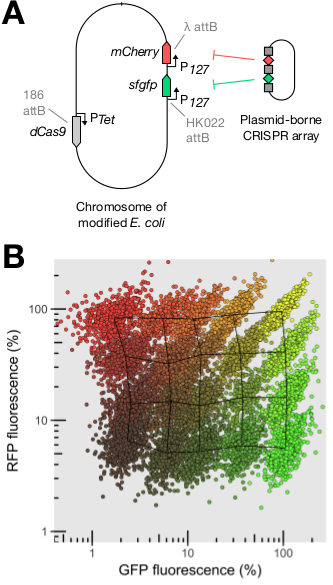Bikard Lab CRISPR Repression Plasmids
The David Bikard Lab at the Institute Pasteur has deposited a collection of CRISPR arrays to modulate the expression levels of two targets independently.
The RNA-programmed DNA-binding protein dCas9 is expressed along a CRISPR array that contains 20 bp "addresses", where dCas9 is going to bind on the chromosome. When dCas9 binds to a gene, it blocks the progression of the RNA polymerase, thus strongly decreasing the expression level. Mismatches between the guide RNA and the target sequence lower the repression level. By controlling the number of mismatches we can obtain a range of expression levels.
This collection comprises 20 plasmids, each carrying two CRISPR guides. The first one binds to sfgfp with either 0, 10, 11, 14 or 20 matching nucleotides, the second binds to mcherry with either 0, 11, 18 or 20 matching nucleotides. Together, these plasmids allow to explore the whole range of expression levels for these two reporters simultaneously. By fusing sfGFP and/or mCherry to genes of interest, it is thus possible to study the effect of the amount and stoichiometry of enzymes.
The pLC97 plasmid allows for quick integration of the aTc-inducible pTet-dCas9 in the attachment site of the phage 186.
Detailed information about the repression system can be found in this article:
Vigouroux A, Oldewurtel E, Cui L, Bikard D, van Teeffelen S. Tuning dCas9’s ability to block transcription enables robust, noiseless knockdown of bacterial genes. Molecular Systems Biology, 2018 Mar 8;14(3):e7899. doi: 10.15252/msb.20177899. PubMed PMID 29519933
Preprint at bioRxiv
Detailed information about chromosomal integration of pLC97 can be found in this article:
St-Pierre et al., One-Step Cloning and Chromosomal Integration of DNA, ACS Synthetic Biology, 2013. DOI: 10.1021/sb400021j

